
Turning Ideas into Accolades: A Guide to STEAM/STEM Accreditation with the National STEAM Association for Your Toy Invention
Submit your STEAM/STEM toy, book, or game for an official STEAM certification. Jump to the application.
In the vibrant world of educational toys, gaining recognition through STEAM (Science, Technology, Engineering, Arts, and Mathematics) or STEM (Science, Technology, Engineering, and Mathematics) accreditation is a powerful validation of your invention’s educational impact. The National STEAM Association stands as a reputable accrediting body, and navigating the accreditation process can propel your toy invention into the spotlight. Here’s your comprehensive guide on how to secure STEAM/STEM accreditation for your innovative creation.
1. Understand STEAM/STEM Principles in Your Toy Invention
Before diving into the application process, ensure that your toy invention authentically integrates STEAM or STEM principles. Reflect on how it stimulates critical thinking, problem-solving, creativity, and other skills associated with these educational disciplines. Familiarize yourself with the specific criteria set by the National STEAM Association, tailoring your invention to align seamlessly.
2. Research Accreditation Criteria in Detail
 Explore the detailed accreditation criteria meticulously laid out by the National STEAM Association, a comprehensive journey that is pivotal in steering your toy invention towards recognition and educational excellence. As you embark on this process, it’s essential to recognize the nuanced and distinctive criteria that exist for diverse types of inventions seeking STEAM/STEM accreditation. In the realm of toys, delve into considerations that transcend mere entertainment, such as the integration of interactive learning methodologies, hands-on engagement strategies, and an overarching evaluation of the educational impact your invention brings to young minds. Pay particular attention to the intricate differentiators between STEM-focused toys and those embracing a broader STEAM approach, where the inclusion of arts becomes a pivotal aspect of the educational narrative. This detailed exploration ensures a holistic understanding of the multifaceted criteria that contribute to the accreditation process, empowering you to tailor your toy invention to meet and exceed the stringent standards set by the National STEAM Association.
Explore the detailed accreditation criteria meticulously laid out by the National STEAM Association, a comprehensive journey that is pivotal in steering your toy invention towards recognition and educational excellence. As you embark on this process, it’s essential to recognize the nuanced and distinctive criteria that exist for diverse types of inventions seeking STEAM/STEM accreditation. In the realm of toys, delve into considerations that transcend mere entertainment, such as the integration of interactive learning methodologies, hands-on engagement strategies, and an overarching evaluation of the educational impact your invention brings to young minds. Pay particular attention to the intricate differentiators between STEM-focused toys and those embracing a broader STEAM approach, where the inclusion of arts becomes a pivotal aspect of the educational narrative. This detailed exploration ensures a holistic understanding of the multifaceted criteria that contribute to the accreditation process, empowering you to tailor your toy invention to meet and exceed the stringent standards set by the National STEAM Association.
3. Prepare a Comprehensive Application
Craft an application that acts as a compelling narrative for your toy invention. Clearly articulate how your creation aligns with STEAM/STEM principles and elucidate how it transcends mere entertainment to foster educational growth. Include detailed information, prototypes, and possibly interactive demonstrations to substantiate your claims. Clearly communicate the learning outcomes your invention aims to achieve and how it contributes to the broader STEAM/STEM educational landscape.
4. Showcase Practical Applications and Benefits
Highlight practical applications and real-world benefits that your toy invention offers. Illustrate how it facilitates hands-on learning, problem-solving, or creative exploration. Offer examples or scenarios that showcase how users, whether children or educators, can integrate your invention into educational settings for maximum impact.
5. Emphasize Innovation and Uniqueness
Clearly communicate the innovative aspects and uniqueness of your toy invention. Showcase any proprietary technologies, creative design elements, or educational methodologies that set your creation apart. Emphasize how your invention pushes the boundaries of traditional educational toys and brings a fresh perspective to STEAM/STEM learning.
6. Provide User Testimonials and Endorsements
Include testimonials and endorsements from users who have experienced the educational benefits of your toy invention. These testimonials serve as powerful endorsements, providing real-world evidence of the positive impact your invention has on learning and development.
7. Stay Engaged and Responsive
After submitting your application, stay engaged with the accreditation process. Be responsive to any requests for additional information or clarification from the National STEAM Association. Demonstrating your commitment to transparency and collaboration enhances your credibility during the evaluation.
8. Leverage Accreditation for Visibility and Impact
Once accredited, leverage the recognition to amplify your toy invention’s visibility. Use the accreditation logo in marketing materials, connect with educational communities, and explore partnerships with schools or educational programs. Accreditation from a reputable organization like the National STEAM Association adds significant value and trust to your invention.
In conclusion, the journey to STEAM/STEM accreditation for your toy invention is a strategic process that aligns your creation with educational excellence. By carefully navigating the application and showcasing the unique educational value of your invention, you position yourself at the forefront of educational innovation, where learning and play converge in the exciting realms of STEAM/STEM.
